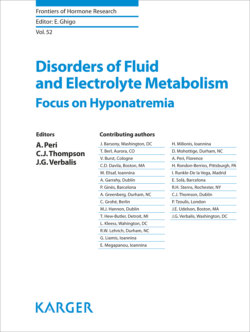Читать книгу Disorders of Fluid and Electrolyte Metabolism - Группа авторов - Страница 30
На сайте Литреса книга снята с продажи.
Homeostatic Response to Changes in Plasma Tonicity
ОглавлениеFigure 1a and b depict the normal response to hypertonicity and hypotonicity, respectively. Figure 2a shows the sequence of events that occur in states of water deprivation. Water is continuously lost from the body in sweat, stool, etc. If this water is not replaced by drinking, plasma tonicity increases. This increase is sensed by osmoreceptors in the OVLT. Stimulation of osmoreceptors has dual effects: It stimulates thirst, which drives drinking behavior, and also stimulates the release of vasopressin by the posterior pituitary. Vasopressin will increase the water permeability of the principal cells in the CNT and CD. The increased water reabsorption decreases the urine volume and increases its osmolality producing a concentrated urine. When coupled with increased thirst, free water deficit and plasma tonicity are restored towards a normal level.
Fig 2. Gamblegrams of total body exchangeable cations and total body water in hypotonic hyponatremia. As evident from analyzing the Edelman equation, hyponatremia develops when the ratio of total exchangeable body cations, sodium (NaE) and potassium (KE), to total body water (H2O) is decreased causing an excess free water (diagonal line, shaded areas). Such a decrement in the ratio can occur when: (a) total exchangeable body cations are normal and total body water is increased, for example, primary polydipsia; (b) both total exchangeable body cations and total body water are decreased but total body water is still greater than total exchangeable body cations, for example, hypovolemia; (c) both total exchangeable body cations and total body water are increased but total body water is greater than total exchangeable body cations, for example, cirrhosis and heart failure; and (d) total body exchangeable body cations are increased and total body water is decreased, for example, syndrome of inappropriate ADH. Dotted line indicates normal levels of total body exchangeable cations and total body water.
Figure 2b depicts the events that occur in response to excessive intake of fluids. The ingested water is distributed in all body fluids. Since the total body sodium is unchanged, plasma sodium and tonicity decrease. This decrease is sensed by osmoreceptors in the OVLT causing the dual effects of decreasing thirst sensation and inhibiting the release of vasopressin. In the absence of vasopressin, water permeability of the principal cells in the CNT and CD is decreased. This reduction decreases water reabsorption, increasing the urine volume and decreasing urine osmolality producing diluted urine. When coupled with decreased thirst, plasma sodium and tonicity will increase towards a normal level.
Fig 3. Pathophysiology of hypotonic hyponatremia. EABV, effective arterial blood volume; SIADH, syndrome of inappropriate ADH release; GFR, glomerular filtration rate.
